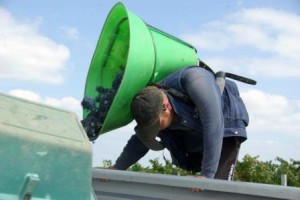Learn everything about Cotes de Bordeaux wine, with a history of the Cotes de Bordeaux appellation, a look at the style and character of the wines, with detailed profiles on all the top wines, wineries, vineyards, and winemakers, with wine tasting notes, histories, best vintages and buying guides for all the tops wines.
For a look at other, important Bordeaux value wine regions: Bordeaux Value Wine Appellation Guide
If you want to read about other Bordeaux wine producers in different Bordeaux appellations: Links to all Bordeaux Wine Producer Profiles If you are interested in learning more about Bordeaux wine, we offer numerous articles on everything about Bordeaux wine, from a history of the Bordeaux region and the famous 1855 Classification, the grapes used to produce Bordeaux wine and even vintage summaries, covering Bordeaux wine from 1900 to today: All About Bordeaux Wine Guide
- Alcee
- Bel-Air la Royere
- Belle Coline
- Clos L’Eglise
- Clos Lunelles
- d’Aiguilhe
- d’Aiguilhe Querre
- Domaine de l’A
- Cap de Faugeres
- Clos Puy Arnaud
- Cote Montpezat
- de Perenne
- Fougas Maldoror
- de-Francs
- Gigault Cuvee Viva
- Joanin Becot
- l’Aurage
- La Prade
- Les Bertrands
- Les Grands Marechaux
- Montlandrie
- Puygueraud
- Roncheraie
Cotes de Bordeaux is the youngest AOC appellation in Bordeaux. Cotes de Bordeaux was created in 2009, when the INAO declared the merging of four, previously recognized communes, Cotes de Blaye, Cotes de Bordeaux, Cotes de Castillon, and Cotes de Francs. The appellation consists of more than 11,000 hectares cultivated with vines. Over 1,000 growers are active in the region.
The following changes took place for wines labeled Cotes de Bordeaux starting with the 2009 vintage. Wines from Cotes de Castillon became Castillon Cotes de Bordeaux. Although wines from Cotes de Castillon retained the rights to be listed as Cotes de Castillon on their label as well. Cotes de Francs became Francs Cotes de Bordeaux. Premieres Cotes de Blaye became Blaye Cotes de Bordeaux. Premieres Cotes de Bordeaux Rouge became Cadillac Cotes de Bordeaux.
While the Cotes de Bordeaux appellation was officially created in 2009, the genesis of the idea was planted in 1985 when the separate, but distinctive regions banded together to create the Association de Cotes de Bordeaux. The name eventually changed to Les Cinq Cites de Bordeaux, to include additional appellations.
Things started coming together by 2003, and in 2009, the new Cotes de Bordeaux appellation was created with the purpose of helping to promote the wines from the previously separate appellations as a united group. The specific appellations were chosen because they shared similar terroirs of gravel, clay, and limestone soils.
Another consideration was the fact that the vast majority of the wines produced in those soils were dominated by the Merlot grape. One problem or virtue, (Depending on your point of view) found in the new appellation is the ability for producers from any terroir in the now, very large Cotes de Bordeaux appellation to incorporate grapes from any of the previously, separate appellations; Cotes de Castillon, Cotes de Blaye, Cotes de Bordeaux, and Cotes de Francs into their wine.
The new, 12,653 hectare, Cotes de Bordeaux appellation produces close to 14% of all Bordeaux wine! 1,500 growers are actively making wine in the Cotes de Bordeaux appellation. The largest commune in the Cotes de Bordeaux appellation is Cotes de Blaye, with 7,729 hectares under vine.
Most Cotes de Blaye wines are not exported. For unknown reasons, the Cotes de Bourg appellation declined to be part of the new, Cotes de Bordeaux appellation designation.
The best vintages of the wines of Cotes de Bordeaux are: 2023, 2022, 2021, 2020, 2019, 2018, 2017, 2016, 2015, 2012, 2010, 2009, 2008, 2005, 2001 and 2000. Older vintages should have been consumed already.
The Cotes de Bordeaux appellation is situated not far from St. Emilion and it is also close to the Dordogne and Garonne rivers. The diverse array of terroirs has a range of clay, gravel, and limestone soils. The best terroirs of Cotes de Bordeaux are similar to St. Emilion or Pomerol, especially at the top estates.
Merlot and Cabernet Franc occupy the largest portions of the area’s vineyards. But Cabernet Sauvignon along with Malbec and Petit Verdot are also planted in smaller amounts. While the majority of Cotes de Bordeaux is devoted to the production of red Bordeaux wine at 97% of the region’s production, white wine is also produced here.
3% of Cotes de Bordeaux is devoted to making a small amount of dry, white Bordeaux wine from mostly Sauvignon Blanc, Semillon, Muscadelle, and Sauvignon Gris, although a few estates plant minor amounts of other grape varieties to produce dry white Bordeaux wine.
The best wines in the Cotes de Bordeaux appellation come from the Cotes de Castillon appellation. But quality wines are produced from the region’s other terroirs found in Cotes de Blaye, Cotes de Bordeaux and Cotes de Francs as well.
For more information on Cotes de Bordeaux www.bordeaux-cotes.com

